The ZenWiFi BD4 was first available at the end of 2024. I’ve used one since the beginning of 2025 and intended to review it first. However, I ended up testing the slightly higher-end ZenWiFi BD5 due to the availability of its outdoor option, among other things, and realized the two are mostly identical.
The ZenWiFi BD4 supposedly also has an outdoor option, the ZenWiFi BD4 Outdoor, but it’s not been readily available.
This quick review aims to demonstrate that the ZenWiFi BD4 is very similar to the ZenWiFi BD5 in real-world usage, with the latest firmware, despite their one major difference in hardware specs. It’ll help you decide which one to pick. The two are so similar that I decided not to test the ZenWiFi BD4 for official performance scores. You can use those of the ZenWiFi BD5 as a reference.
Here’s the bottom line: If you have a wired home, the ZenWiFi BD4 is a better deal than its stronger cousin thanks to the lower cost. For those with Gigabit or lower broadband, the two are practically the same in real-world experience, no matter how you use them. However, if you want to get a bit more than Gigabit, the ZenWiFi BD5 has a slight edge in a fully wireless setup.
If you have higher bandwidth needs, pick a tri-band Wi-Fi 7 ZenWiFi alternative instead.
Dong’s note: I first published this piece on December 4, 2024, as a preview and updated it to a review on September 7, 2025, after extended real-world usage.
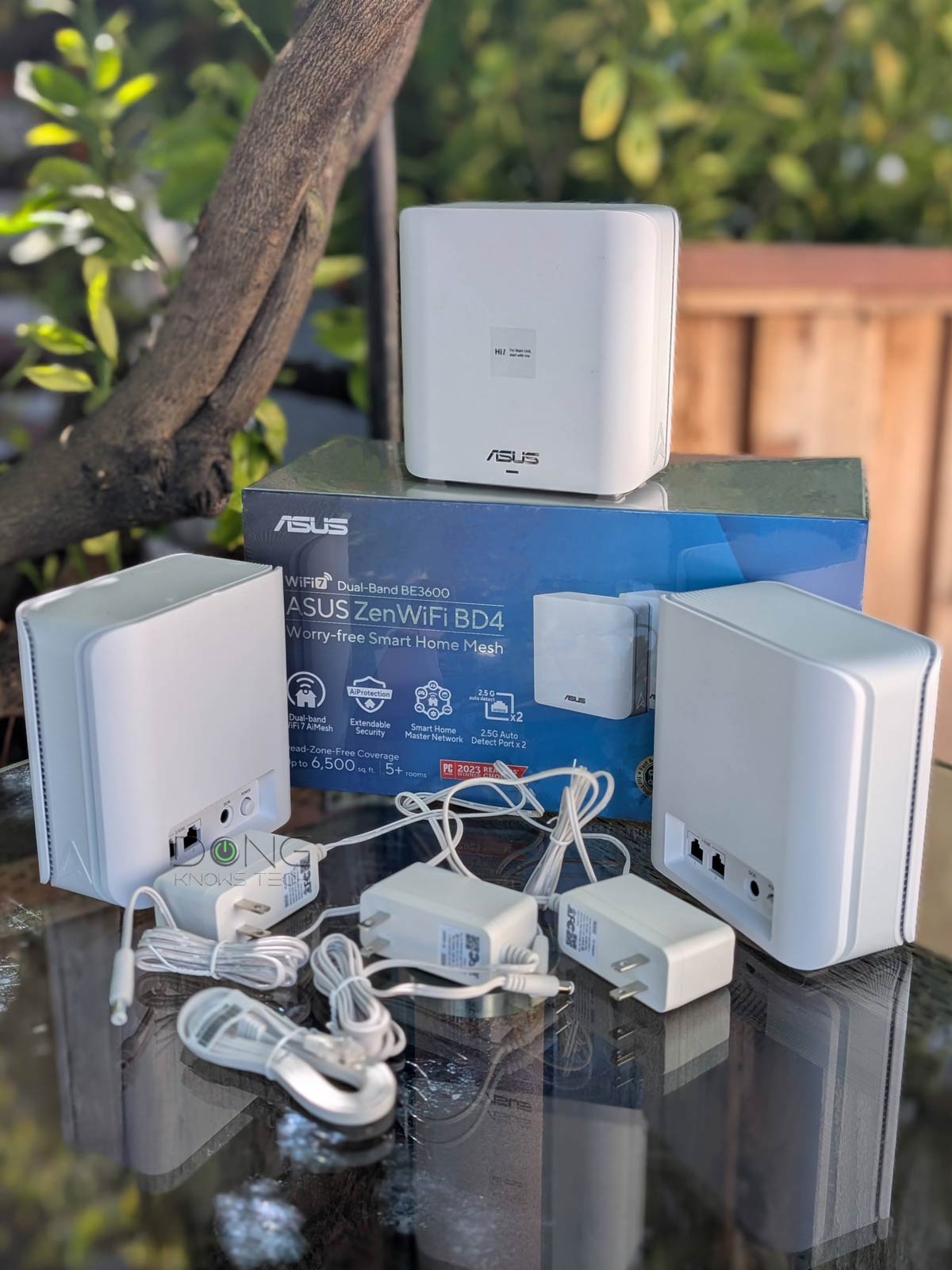
ASUS ZenWiFi BD4: The bare-minimum Wi-Fi 7 ZenWiFi
If the ZenWiFi BD5 is the rival of the TP-Link Deco BE25, the ZenWiFi BD4 is the answer to the Deco BE23 (a.k.a Deco BE3600). It represents ASUS’s bare minimum in Wi-Fi 7 hardware, with a total theoretical bandwidth of 3600Mbps. To put things in perspective, many Wi-Fi 6 or Wi-Fi 6E sets, such as the ZenWiFi XT8 and ET8, for example, each have 6600Mbps of total Wi-Fi bandwidth.
The low bandwidth results from the fact that the BD4 has only two bands—5GHz and 2.4GHz—instead of three, unlike the BT8 or BT10. Additionally, its Wi-Fi hardware also has entry-level specs. Specifically, its 5GHz band doesn’t feature 240MHz channel width, which the ZenWiFi BD5 does—this is the only difference between the two.
Per ASUS’s naming convention, “BD4” means the hardware features dual-band Wi-Fi 7 with four streams in total.
Since late 2024, the dual-band approach has become familiar in Wi-Fi 7 broadcasters. There have been numerous dual-band routers and Wi-Fi systems from different vendors. They are a testament to the fact that the 6GHz band is complicated. The cabinet below includes some details about how this band is being adopted around the world.
How the 6GHz band is regulated around the world
The 6GHz band has a total width of 1200 MHz, ranging from 5.925 MHz to 7.125 MHz, and is divided into 59 channels of 20 MHz each. These channels are grouped to create “sub-bands,” which also vary from one region to another.
In the U.S., the FCC has designated four sub-bands across the entire 6GHz spectrum, including UNII-5, UNII-6, UNII-7, and UNII-8, for Wi-Fi use, though portions of the band may be reserved for other applications.
The E.U. Commission allows only the UNII-5 equivalent part of the frequency for Wi-Fi use, which is 480 MHz in width from 5925 MHz to 6425 MHz. Some other parts of the world are somewhere in between, with the UNII-5 portion adopted and the rest being considered. In the rest, this band may not even be available for Wi-Fi at all.
Generally, Wi-Fi 6E needs a 160MHz channel to deliver the best performance, and Wi-Fi 7 requires double that, 320MHz. Due to spectrum availability and other reasons, real-world hardware tends to use narrower channels in most cases.
Overall, the use of the 6GHz frequency is complicated and is the main reason a Wi-Fi broadcaster made for one region might not work in another.
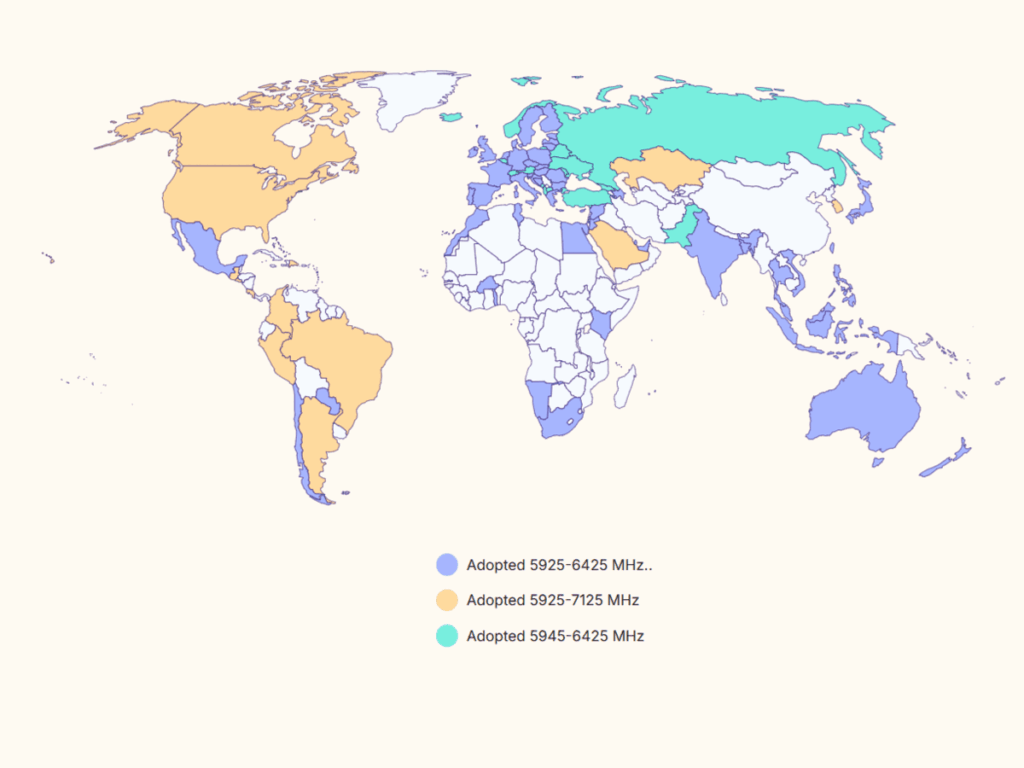
The table below shows its current adoption worldwide. The “Considering” portion is generally slated to be finalized eventually, though that varies from one region to another.
| Country | Adopted Spectrum |
|---|---|
| United States | 5925-7125 MHz (entire band including UNII5, UNII-6, UNII-7, and UNII-8) |
| Albania | 5945-6425 MHz (UNII-5) |
| Andorra | 5945-6425 MHz |
| Argentina | 5925-7125 MHz |
| Australia | 5925-6425 MHz |
| Austria | 5945-6425 MHz |
| Azerbaijan | 5925-6425 MHz |
| Bahrain | 5925-6425 MHz |
| Bangladesh | 5925-6425 MHz |
| Belarus | 5945-6425 MHz |
| 5945-6425 MHz | |
| Belgium | 5945-6425 MHz |
| Bosnia and Herzegovina | 5945-6425 MHz |
| Brazil | 5925-7125 MHz |
| Bulgaria | 5945-6425 MHz |
| Burkina Faso | 5945-6425 MHz |
| Canada | 5925-7125 MHz |
| Chile | 5925-6425 MHz |
| Colombia | 5925-7125 MHz |
| Costa Rica | 5925-7125 MHz |
| Croatia | 5945-6425 MHz |
| Cyprus | 5945-6425 MHz |
| Czech Republic | 5945-6425 MHz |
| Denmark | 5945-6425 MHz |
| Dominican Republic | 5925-7125 MHz |
| Egypt | 5925-6425 MHz |
| El Salvador | 5925-7125 MHz |
| Estonia | 5945-6425 MHz |
| European Union | 5945-6425 MHz |
| Faroe Islands | 5945-6425 MHz |
| Finland | 5945-6425 MHz |
| France | 5945-6425 MHz |
| Georgia | 5945-6425 MHz |
| Germany | 5945-6425 MHz |
| Gibraltar | 5945-6425 MHz |
| Greece | 5945-6425 MHz |
| Guatemala | 5925-7125 MHz |
| Honduras | 5925-7125 MHz |
| Hong Kong | 5925-6425 MHz |
| Hungary | 5925-6425 MHz |
| Iceland | 5945-6425 MHz |
| India | 5945-6425 MHz |
| Ireland | 5945-6425 MHz 6425-7125 MHz |
| Isle of Man | 5945-6425 MHz |
| Italy | 5945-6425 MHz |
| Japan | 5925-6425 MHz 6425-7125 MHz |
| Jordan | 5925-6425 MHz |
| Kazakhstan | 5925-7125 MHz |
| Kenya | 5925-6425 MHz |
| Latvia | 5925-6425 MHz |
| Liechtenstein | 5945-6425 MHz |
| Lithuania | 5945-6425 MHz |
| Luxembourg | 5945-6425 MHz |
| Macao | 5945-6425 MHz |
| Macedonia | 5945-6425 MHz |
| Malaysia | 5925-6425 MHz |
| Malta | 5925-6425 MHz |
| Mauritius | 5925-6425 MHz |
| Mexico | 5925-6425 MHz |
| Moldova | 5925-6425 MHz |
| Monaco | 5945-6425 MHz |
| Montenegro | 5945-6425 MHz |
| Morocco | 5925-6425 MHz |
| Namibia | 5925-6425 MHz |
| Netherlands | 5945-6425 MHz 6425-7125 MHz |
| New Zealand | 5925-6425 MHz |
| Norway | 5945-6425 MHz |
| Pakistan | 5945-6425 MHz |
| Paraguay | 5925-6425 MHz |
| Peru | 5925-7125 MHz |
| Philippines | 5925-7125 MHz |
| Poland | 5925-7125 MHz |
| Portugal | 5945-6425 MHz 6425-7125 MHz |
| Qatar | 5925-6425 MHz |
| Romania | 5925-6425 MHz |
| Russian Federation | 5925-6425 MHz |
| San Marino | 5925-6425 MHz |
| Saudi Arabia | 5925-7125 MHz |
| Singapore | 5925-6425 MHz |
| Slovakia | 5925-6425 MHz |
| Slovenia | 5925-6425 MHz |
| South Africa | 5925-6425 MHz |
| South Korea | 5925-7125 MHz |
| Spain | 5945-6425 MHz |
| Sweden | 5945-6425 MHz |
| Switzerland | 5945-6425 MHz |
| Thailand | 5925-6425 MHz |
| Togo | 5925-6425 MHz |
| Tunisia | 5925-6425 MHz |
| Turkey | 5925-6425 MHz |
| Ukraine | 5925-6425 MHz |
| United Arab Emirates | 5925-6425 MHz |
| United Kingdom | 5945-6425 MHz |
| Holy See (Vatican City State) | 5945-6425 MHz |
| Vietnam | 5945-6425 MHz |
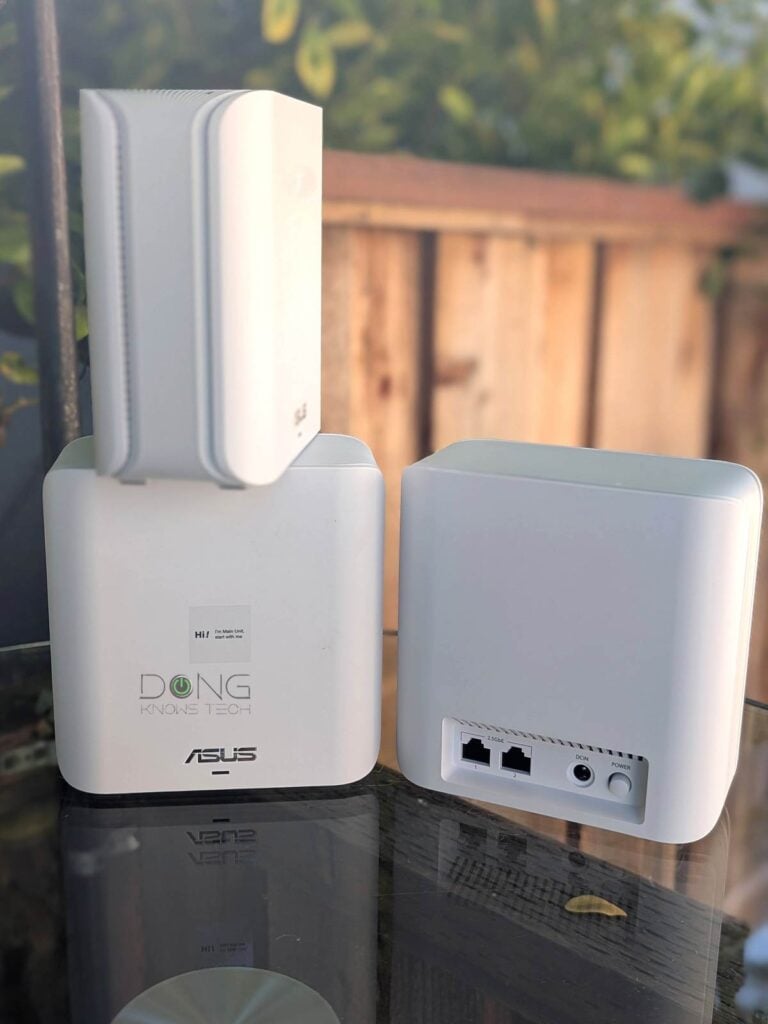
Compact, 2-port design
Like all ZenWiFi sets, the ZenWiFi BD4 includes identical mesh routers. Pick one as the primary unit (the rotuer) and the rest will work as satellites.
Each ZenWiFi BD4 mesh router shares the same shape and size as that of the ZenWiFi BD5—you literally can’t tell the two apart unless you look at the retail box or their underside, where the model names are. It’s the same design as previous Wi-Fi 7 hardware in the ZenWiFi family, but it is significantly smaller.
On the back, each ZenWiFi BD4 mesh router also has two auto-sensing 2.5Gbps Multi-Gig network ports. On the router (or primary) unit, the one that connects to the Internet source will work as the WAN port, and the other will work as a LAN. On a satellite unit, both work as a LAN, or you can use either as the uplink in a wired backhaul setup.
Considering the hardware’s entry-level Wi-Fi specs, the 2.5Gbps ports make sense in terms of real-world bandwidth. The table below shows how the ZenWiFi BD4 is stacked up against the ZenWiFi BD5 and the dual-band TP-Link Deco counterpart.
Hardware specifications: ASUS ZenWiFi BD4 vs. ASUS ZenWiFi BD5 vs. TP-Link BE3600
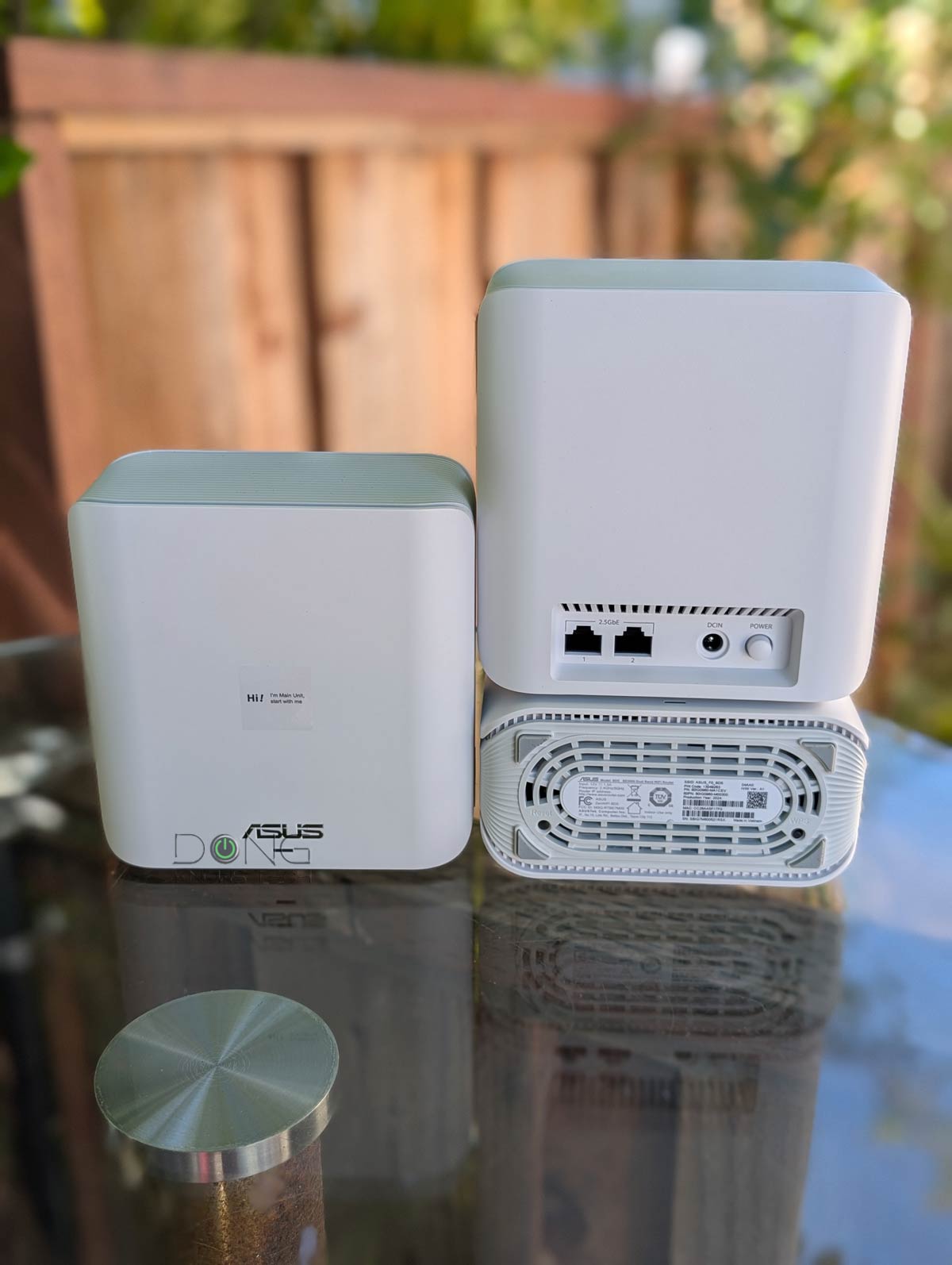 | 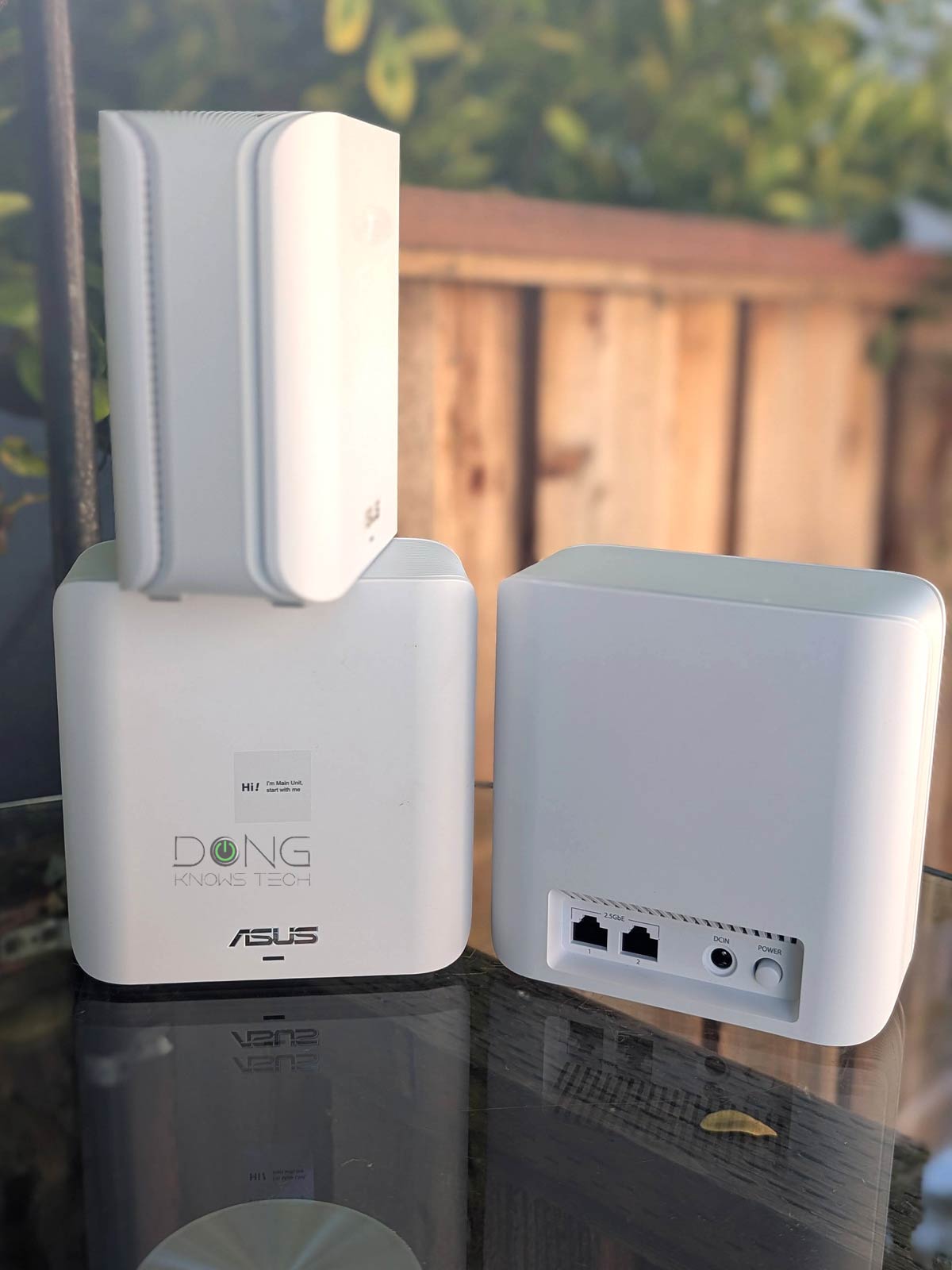 |  | |
|---|---|---|---|
| Model | ZenWiFi BD5 | ZenWiFi BD4 | Deco BE23, TP-Link BE3600, Deco WB10800 |
| Pre-Synced Hardware | Yes | ||
| Possible Dedicated Backhaul Band (default) | None | ||
| Wired Backhaul | Yes | ||
| Dimensions (WxDxH) | 5.51 x 2.76 x 5.51 in (140 x 70 x 140 mm) | 5.91 × 5.91 × 2.44 in (150 × 150 × 62 mm) | |
| Weight | 1.15 lbs (520 g) | 1.12 lbs (508 g) | |
| Processing Power | Quad-core 1.5 GHz CPU, 128 MB flash, 512 GB RAM | undisclosed | |
| Wi-Fi Bandwith | Dual-band BE5000 | Dual-band BE3600 | |
| 1st Band (2.4GHz) | 2×2 BE: Up to 688Mbps (20/40MHz) | ||
| 2nd Band (5GHz) | 2×2 BE: Up to 4324Mbps (20/40/80/160/240MHz) | 2×2 BE: Up to 2882Mbps (20/40/80/160MHz) | |
| Automated Frequency Coordination (AFC) | N/A (only applicable to the 6GHz band) | ||
| Multi-Link Operation (MLO) | Yes | ||
| Backward Compatibility | 802.11ax/ac/n/g/a/b | ||
| Guest Network | Yes (flexible) | Yes (one SSID assigned to one or both bands) | |
| IoT Network | Yes (flexible) | Yes (one SSID assigned to one or both bands) | |
| Mobile App | ASUS Router | Deco | |
| Web User Interface | Comprehensive | Simple (status only, no local management) | |
| AP Mode | Yes (as a router or a mesh) | ||
| USB Port | None | ||
| Gigabit Port | None | 2x Auto-Sensing | |
| Multi-Gig Port | 2x 2.5Gbps Auto-Sensing | None | |
| Dual-WAN and Link Aggregation | No | ||
| Firmware Version (at review) | 3.0.0.6.102_58118 | 3.0.0.6.102_58130 | Not yet tested |
| U.S. Release Date | January, 2025 | December 2024 | November 19, 2024 |
| Power Specs | Input: 100-240V Output: 12V 1.5A | Input: 100-240V Output: 12V 0.8A | |
| Real-World Power Consumption (per 24 hours) | ≈155 Wh (router) ≈125 Wh (satellite) | Not tested | |
| U.S. Launch Price (Compare current prices!) | $349.99 (3-pack) $249.99 (2-pack) $139.99 (single router) $179.99 (outdoor router) | $299.99 (3-pack) $229.99 (2-pack) $129.99 (single router) | $249.99 (3-pack) $179.99 (2-pack) $79.99 (single router) |


ZenWiFi BD4 vs. ZenWiFi BD5: The key difference
As noted on the table above, the only difference between the two dual-band ZenWiFi sets is the fact that the BD4 does not support the 240MHz channel width, whereas the BD5 does. The wider the channel, the higher the wireless bandwidth.
So how significant is this? That depends.
On the front end, all existing Wi-Fi 7 clients I’ve encountered don’t support the 240MHz channel width. They switch between 160MHz and 320MHz.
As a result, when you use these dual-band ZenWiFi sets with wired backhauling, or as a single router, there’s no difference between the two from a client’s perspective. Both will deliver the top theoretical speed of 2882Mbps on the 5GHz band.
Fronthaul vs. backhaul
When you use multiple Wi-Fi access points—in a mesh Wi-Fi system or a combo of a Wi-Fi router and an extender—there are two types of connections: fronthaul and backhaul.
Fronthaul is the Wi-Fi signals broadcast outward for clients or the local area network (LAN) ports for wired devices. It’s what we generally expect from a Wi-Fi broadcaster.
Backhaul (a.k.a. backbone), on the other hand, is the link between a Wi-Fi satellite unit and the network’s primary router, or between satellite units.
This link works behind the scenes to keep the hardware units together as a system. It also determines the ceiling bandwidth (and speed) of all devices connected to the particular Wi-Fi satellite unit.
At the satellite/extender unit, the connection used for the backhaul—a Wi-Fi link (wireless) or a network port (wired)—is often called the uplink. In a wireless uplink, keep the following in mind:
- Hardware of Wi-Fi 6e, Wi-Fi 6, or Wi-Fi 5 standards uses one of its bands (2.4GHz, 5GHz, or 6GHz) for the uplink. In this case:
- When a Wi-Fi band handles backhaul and fronthaul simultaneously, only half its bandwidth is available to either end.
- When a Wi-Fi band functions solely for backhauling, often available traditional Tri-band hardware, it’s called the dedicated backhaul.
- Most Wi-Fi 7 satellite units can use multiple bands for the backhaul link thanks to the MLO feature.
For the best performance and reliability, network cables are recommended for backhauling—wired backhauling, which is an advantage of mesh Wi-Fi hardware with network ports. In this case, a Wi-Fi satellite unit can use its entire Wi-Fi bandwidth for the fronthaul.
On the other hand, the ZenWiFi BD5 is clearly better than the ZenWiFi BD4 in a fully wireless setup. In this case, the 240MHz channel width is utilized in the former’s wireless backhaul link, allowing it to have up to 4324Mbps of theoretical bandwidth on the 5GHz, compared to 2882Mbps of the latter. A stronger backhaul means more bandwidth for the clients at the satellite unit.
If you’re wondering if you can mix the ZenWiFi BD4 and ZenWiFi BD5 in a single system, the answer is yes, but only when you use wired backhauling. More on that in the post linked below.
Another familiar ZenWiFi system
Other than the difference in Wi-Fi specs, the ZenWiFi BD4 proved to be identical to the ZenWiFi BD5 in my experience, including the fact that it’s among a few that don’t support universal backup and restore, meaning you can’t port the settings of an existing ASUS router onto it in an upgrade.
Overall, here’s what you can expect from it:
- The support for MLO: The hardware comes with MLO out of the box. When you get a pack and use the wireless mesh system, the hardware automatically uses an MLO link as the backhaul, dubbed “Smart Haul” by Asus. Note that MLO is only available as backhaul when the satellite unit connects directly to the primary router unit.
- Pre-synced hardware: When you get a pack, the identical hardware units are pre-synced. All you need to do is pick one unit to set up as the primary router—one of them comes with a removable “Main Unit” label for easy identification, though you can pick any—and the rest will be part of the system when plugged in.
- Part of the AiMesh family: Technically, the ZenWiFi BD4 can work with any AiMesh-enabled router (virtually all ASUS routers released since Wi-Fi 6) to form a Wi-Fi system. However, for the best performance, specific rules apply.
- ASUSWRT 5.0 firmware and core features:
- Multiple SSIDs via the “Smart Home Master” feature.
- Safe Browsing with DNS filters via specific servers.
- Useful Parental Controls and an advanced VPN feature set, which includes VPN Fusion and Instant Guard.
- Advanced QoS and online protection (via AiProtection) to keep your network and devices safe.
- A comprehensive set of network settings and features is managed via the web user interface or the (optional) ASUS Router mobile app, which requires no login account or subscription.
The gist is that if you’ve used an ASUS router before, the new ZenWiFi BD4 will be a familiar experience. It’s worth noting that, generally, it’s best to set it up using the web user interface and opt for the ASUS mobile app afterward for convenience.
Tip
Avoid using the ASUS mobile app, at least for the setup process. The app is generic and lacks specifics applied to a particular Asus router. While this app might work in most cases and is convenient for monitoring your network, it can cause unknown and unexpected issues when used to set up new hardware or make specific changes to the system. If that’s your case, reset the hardware and set it up again using the web user interface before using the app if you can’t resist it.
ZenWiFi BD4: Reliable Gig+ performance with the latest firmware
As mentioned, for this review, I used the ZenWiFi BD4 for an extended period of time, months. Initially, the mesh set proved to be quite buggy with the initial firmware versions. However, with the latest one, it has been reliable.
It’s worth noting that I used it with wired backhaul, which is the only way you should use it, and the real-world data rates were almost identical to those of the ZenWiFi BD5. For this reason, I decided not to repeat the whole testing process, which would take me quite a bit of time. You can use the performance charts of the BD5 to get an idea of what you can expect.
Overall, considering the 2.5Gbps port and minimum Wi-Fi 7 specs, the ZenWiFi BD4 delivers speeds up to Gig+. So if you have Gigabit or lower broadband, it’ll work out well.
ASUS ZenWiFi BD4's Rating
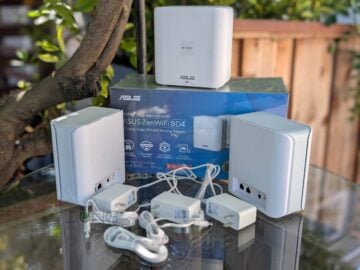
Pros
Dual-band Wi-Fi 7 with two 2.5Gbps ports and reliable performance, affordable
ASUSWRT 5.0 has lots of customizations and free-for-life high-end features (VPN, Parental Controls, Online Protection, Smart Home Master, etc.).
Robust web user interface and helpful optional mobile app; easy-to-blend-in design
Compact with no internal fan
Cons
Only two network ports; bare-minimum Wi-Fi 7 specs
Not wall-mount-ready
The takeaway
The ASUS ZenWiFi BD4 is not earth-shattering, but it has enough to deliver Gigabit-class, even Gig+, real-world performance, especially when used in a wired home. That, plus the comprehensive set of features known among ASUS’s ZenWiFi hardware, makes it a formidable contender among the dual-band Wi-Fi 7 mesh crowd. Consider one today!



One thing I discovered is that the BD5 does not support UPnP whereas the BD4 does. Important for me using the JPLAY app accessing music files in my network.
I’m not aware of this but generally, you don’t need UPnP on the router for UPnP to work on connected devices, Steve.
Thanks. Seems I was mistaken re: the BD5. After accessing the manual from the B&H site it indicates that UPnP is supported but “off” by default. Investigating further it seems the older BD4 would be a better option. Network speed is not critical. And I need 3 units, as I have many devices that require network access, but do not have WiFi built in. And the location and distances from the access points to one another would make wired back haul a problem. My current set of TP-Link XE5300’s have proved less reliable than I’d hoped. Had to have them replaced already with the first 6 months for various failures of the satellites. That’s what led me to investigate the ASUS as well as the more costly Netgear alternatives.
I’d go with the Asus among the three, Steve.
Hi Dong,
Thanks for the review and keep up the great work your are doing!
I need a cheap AImesh node for my main router RT-BE86U.
I have a separated vlan (sdn) (192.168.53.xxx) for the IOT devices and some scripting in the jffs partition for all to work.
I have some devices with low wifi signal in the garage, so i was wondering if adding a BD4 node i can sync the IOT vlan (sdn), in context of guest network Pro (if it supports it).
I´m planning using a wireless backhaul, because i just need to connect this devices and they don´t use much bandwidth.
I tried adding and old RT AC86U (not WRT 5.0) has a node and it didn´t sync the IOT vlan.
Thanks
For a wireless setup, you need multiple RT-BE86U units, Tiago. More here.
Thanks for your answer.
My second choice was to buy a RT BE92U , it´s cheaper.
It’s more expensive if you need two units. A single RT-BE92U doesn’t have the same Wi-Fi coverage as a 2-pack ZenWiFi set.
Getting my first mesh system and considering this. We are a family of 6 with young children, but with all the smart home items these days, we have currently 67 devices connected to our Wi-Fi.
We only get 1gig inbound, and nothing we do demands a ton of bandwidth. Mainly just a couple of TV’s, XBOX, etc. My PC is wired to a switch.
Do you feel these units can handle that many connections reliably?
That depends on what type of devices you have, Spencer. If most of them are Wi-Fi 5 or older, you’ll need to set up the SSID accordingly, etc. So there’s no simple answer to that question, but if you pay attention and set things up properly, it’ll work well. Good luck!
Dong, thank you very for this review and in general for all the content you have here, really top-class material.
Meanwhile, I’d like to ask your help/advise on something. Currently I’m trying to choose a good and solid mesh system, capable of delivering speed and with good coverage. I have a 1Gbps service and I’m thinking on buying a system with 2 devices and although I want be prepared for the future (most of my main devices are already compatible with wifi 6e) I don’t want to spent much more than 250 euros.
Currently I’m divided between the ZenWifi BD4 (155 euros) and the Deco XE75 (230 euros). What would you recommend for me? As I can’t have a LAN Backhaul, probably the Deco, using the 6GHz channel for backhauling am I correct? or would you advise me any different?
Kind regards,
Miguel Roberto
You can’t count on the 6GHz band as backhaul, Miguel. I’d go with the BD4 and running a network cable to link the units.
Hi Dong, Currently on an extended garden leave sponsored by my employer before early retirement I have a lot of time on my head, which to a large degree I spent reading.your great articles and reviews. Thank you in first place for your work and also making all these topics more approachable. Spending more time in my house I now feel like something could be improved, first looking at our WIFI at home. While my son wondered why I am browsing product pages and reviews about routers and mesh systems, because he considers our WIFI good, I am bugged by the low security standard in our solution (WPA), which my iPhone nags me about, and sometimes it takes time until my devices connect. Currently we have Airport Extreme (6th generation, i.e. AC) in the basement and ground floor (as your call it in Germany) and two Airport Extreme 5th generation (N) in the first floor in two different rooms, since with one the signal is not good enough in the opposite room. All configured in bridge mode with wired connection to our DSL router. Would you recommend the BD4 set of 3, one for each floor, as a reasonable update to our Apple Airport setup? We mostly use Apple devices in the house, TV and Playstation are anyway wired through one of the Airports. Ethernet from Router to switch and wiring supports 1GB. Looking forward for your valuable feedback. Best regards Lukas
Thanks for the kinds words, Lukas, and congrats on the early retirement!
It’s impossible for me to answer your questions since I’ve never been to your place. If I were you, though, I’d use the ZenWiFi XD5 (you can get a 2-pack or a 3-pack depending on the coverage need). It’ll be a great upgrade to your current system and Wi-Fi 6 is currently the best standard to get and it will be applicable for years to come.
Good luck!
Hi Dong,
Thanks for your fast reply. The XD5 was also in my consideration, I just tended to the BD4 because it would only cost me one latte more here (256 vs. 252 Euro for the 3-pack) and spec wise (based on Asus’ webpage) they seemed to be very similar, with the BD4 offering Wifi 7 on top. But I also agree with your take on sticking to proven and reliable technology. Then I would probably go with a XD6S (2-pack for 177 Euro) and extend it eventually as needed by another node. Your review of the XD6 sounded more excited and the XD6S only lacks the additional LAN ports, memory of the XD6S is equal to the XD5.
Keep the great work and take care
Lukas
The XD6(S) will do, too. I recommend Wi-Fi 6 because you’re using apple products of which the new ones are generally behind in Wi-Fi support and the old ones simply don’t work with broadcasters the latest Wi-Fi standard. So, among those you mentioned, I’d say get the most affordable. They are all likely the same in real-world usage in your case anyway.
👍
Hi Dong,
do you plan to review the BD4 outdoor unit? Is this the online outdoor unit Asus is selling?
Thank you and greetings from the other side of the pond 🙂
Both the BD4 and BD5 have outdoor variants, Claudio. I haven’t reviewed any but if I do, I’d just pick one since they are similar. We’ll see.
Hi! Just wanted to say thank you for the information and all the comments and answers below. I know nothing about this stuff and still felt like I’ve got great deal of knowledge about it all and could keep up somehow. So yeah thank you.
Would you say this a good deal for a standard router setup, when compared to something like the Asus RT-AX52 (when similarly priced)?
It’ll work as a standalone router, Ila. Good deal or not is subjective. 🙂
Indeed regional pricing & discounts vary drastically. The RT-AX52 is half the price of BD4 in other places, but similarly priced here. Thank you for the response.
I recently got the ASUS RT-BE92u, but ended up moving to a new house, which is much bigger and the router cannot cover the whole house. So I am looking into an AiMesh setup.
My question is, do I sell my RT-BE92u, and get a full mesh setup out of the box, or can I pair my router with 2 or 3 pack of ZenWiFi BD4? Will it work well? It will have to be a wireless backhaul, since wiring is out of the question.
You can get one or two more units of teh RT-BE92U. If not get the ZenWiFi BQ16 Pro, a tri-band Wi-Fi 7 set, or a UNII4-enabled Wi-Fi 6 set, like one of these. If you like the RT-BE92U, the ZenWiFi BD4 or any dual-band set won’t cut it unless you have wired backhauling. Good luck!
What would be the more value option in your opinion? I’m not exactly a power user, and don’t wanna spend 800€+ on a wifi setup.
Thank you so much for your reply tho! Appreciate the food for thought.
Then get one of those UNII-4 Wi-Fi 6 options I mentioned, Rafa. It’s now the best time go buy Wi-Fi 6 hardware.
Looks super interesting for a basic 2 or 3-node setup combined with a 2.5g switch and NAS. Price is very tempting to pick up and experiment with myself.
Assuming there are plans for a more in-depth review to come?
Yes, Robert. Either this one or the BD5, which is similar. I’d say your assessment is correct and it’s safe to get it. Good luck!
Amazon just dropped the 2-pack down to $199.99 and the 3-pack to $269.99. I was considering going a completely different route, but dangit, for $200, a set of 2 of these would sure make things a bit simpler…
Is it possible to use Ethernet backhaul for my Asus mesh system through an unmanaged switch while also connecting other Ethernet devices to the same switch? Specifically, one port of the mesh node is used for WAN, and the other available port should connect to a switch that allows multiple devices and another satellite mesh node via Ethernet backhaul. Would this setup work?
Unsure what node you’re taking about, this post will help. Check out the related links, too.
Thanks, Dong.
I asked about using Asus BD4 with Ethernet backhaul via a switch since it has only two 2.5G ports. One is for WAN, leaving only one for LAN devices and another BD4 satellite unit.
Yes you can use a switch. The previously linked post will explain more in detail. Give it a good read!
Thank you again. Much appreciated!
Has anyone seen the BD4 outdoor version in the wild? I can see adverts but no offers for sale….
More info on that one will be available at CES.
Thank Dong. I have a CD6 x 3 units in a modest 3 bedroom home (UK). Works well for us. However, I’ve just noticed about a week ago that it’s end of life re support. A lot of of UK companies are still selling this as if it current!
I was thinking could I “front end” with a unit like this and benefit from updated security, whilst keeping the CD6 satellites. Our browsing needs are modest.
Many thanks for any advice as I always enjoy and respect your insight.
I’d not worry about “end of life”, Ray. The current hardware should still work for a long time. If you are still concerned, get a Wi-fi 6 AiMesh router as the primary unit. Mixing 7 and 5 is not a good idea.
Thank you Dong. A very helpful reply 😊.
👍
Hey Dong,
Been a long time fan since the old CNET days and am always happy to hear your thoughts on equipment.
Thanks for the honest and practical advice, as it’s saved me a lot in helping avoid succumbing to the FOMO over WiFi 7 (especially when my home network has been running smoothly for the past 2-3 years and prices will inevitably come down).
👍
I’ve been looking at the BD5 which is sold through Best Buy. I’ve was hoping you’d do a review and as usually it helped me make the decision. According to Asus website they have the same specs except the BD5 has BE5000 performance of 688+4323 Mbps. They are only $50 more. I’m going to use them with BE88U to extend around the house via wired backhaul. This is an upgrade to my AX86U and XD4s which I’ve had good luck with for a few years.
Your observation is correct, Jeremy. The BD5 is more like the Deco BE25 than the BD4 which is more like the Deco BE23 (not yet announced but a BE3600 grade). It seems Asus won’t officially announce the BD5 until CES.
I get so lost here. Why is this 5000 one offered with advertised speeds surpassing the 2.5g port ability? What am I missing as to how this is relevant or why this would be worthwhile versus the WAN capability?
That’s why it’s called “advertized” speed, Rory. More here.
Not sure if you’re able to say but, which in your opinion is the “bang for buck” for Gig+ service between these (sale prices): BE63/65 ($450), this BD4 ($300), BE25 ($250), X55 Pro ($190). I bought the 3 Decos on Amazon (yet to arrive) in a panic before deals expired… and now an affordable Asus. Please help an indecisive consumer!
I’d take the BD4 over the BE63 and the X55 pro over the BE25. So the X55 Pro is the best b4b by far in terms of connectivity. But Asus has *much* more in features, all free. So, it’s your call. Make sure you read the reviews for the little details.
I have 3 x ET12 (one ET12 as the router) and 7 x XD4 in my apartment as all the walls are constructed with concrete blocks. All have the latest firmware with AsusWRT 4.0
In 2025 Asus will be upgrading the ET12 to Asus WRT 5.0 but not the XD4. Will WRT 5.0 and WRT 4.0 work together or will I have to eventually replace the XD4s (with Wi-Fi 7 devices such as the BD4)? I was looking forward to the IOT Network, but I imagine this won’t work?
Yes, the two versions generally work with each other. But mixing hardware is always tricky.
Do you have insight if XD6 will get Asus WRT 5.0.
I too suffer from concrete blocks, XD6 two deices unable to service 50sq.m (duplex 100sq.m) unit.
Likely not, Yasin. But i don’t know fo sure. In any case, AsusWRT 5.0 won’t help with range. Run a netwok cable.
Yes, sure I will add new nodes (asuswrt 5.0) for coverage.
Having asuswrt 5.0 could help old nodes as backup WAN links and extend same parental/security feature of new nodes.
👍
Added EBR63 as node to existing XD6.
I don’t really see the point of these as compared to WiFi 6E units. What advantages does WiFi 7 offer on such hardware?
Close to nothing if you compare to Wi-Fi 6e. But all Wi-Fi 6e hardware of the same price point doesn’t have two Multi-Gig ports.
Can this handle up to 60+ connections with TV/game streaming? I’ve been using ZenWiFi 8 AX for the past few years without any issues with dropping. Thanks!
It’s impossible to tell, David, but if the XT 8 is working well, I’d recommend not replacing it just yet. That’s generally the case with all things Wi-Fi.
With this system does it include the Router and then 2 satellite or do I have to purchase a router separately?
ZenWiFi generally includes identical units, Devon, they are all mesh routers, as mentioned in the post. So you get 3-pack or 2-pack according to your needs…
You can also add any AiMesh-ready router to the mix.